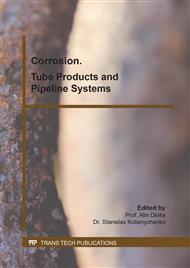[1]
Schumacher, Seawater corrosion handbook, Noyes Data Corp. (1979).
Google Scholar
[2]
T.J. Glover, Copper-Nickel Alloy for the Construction of Ship and Boat Hulls, Brit. Corros. J. 17 (2013) 155-158.
DOI: 10.1179/000705982798274228
Google Scholar
[3]
K.D. Efford, Sea water corrosion of 90-10 and 70-30 Cu-Ni: 14 years exposed, Mater. Performance. 14 (1975) 37-40.
Google Scholar
[4]
N. Asrar, A.U. Malik, S. Ahmad, et al. Early failure of cupro-nickel condenser tubes in thermal desalination plant, Desalination. 116 (1998) 135-143.
DOI: 10.1016/s0011-9164(98)00190-8
Google Scholar
[5]
K. Chandra, V. Kain, G.K. Dey, et al., Failure analysis of cupronickel evaporator tubes of a chilling plant, Eng. Fail. Anal. 17 (2010) 587-593.
DOI: 10.1016/j.engfailanal.2009.10.014
Google Scholar
[6]
Y.G. Zheng, Z.M. Yao, Y.S. Zhang, et al. Erosion-corrosion synergism and erosion-corrosion resistant alloy development, Acta Metall. Sin. 36 (2000) 51.
Google Scholar
[7]
A. Neville, T. Hodgkiess, J.T. Dallas, A study of the erosion-corrosion behavior of engineering steels for marine pumping applications, Wear. 186 (1995) 497-507.
DOI: 10.1016/0043-1648(95)07145-8
Google Scholar
[8]
T.D. Burleigh, D.H. Waldeck, Effect of Alloying on the Resistance of Cu10% Ni Alloys to Seawater Impingement, Corrosion. 55 (1999) 800-804.
DOI: 10.5006/1.3284036
Google Scholar
[9]
K.D. Efird, The Synergistic Effect of Ni and Fe on the Sea Water Corrosion of Copper Alloys, Mater. Performance. 33 (1977) 347.
DOI: 10.5006/0010-9312-33.10.347
Google Scholar
[10]
Badawy, A. Waheed, K.M. Ismail, A.M. Fathi, Effect of Ni content on the corrosion behavior of Cu–Ni alloys in neutral chloride solutions, Electrochim. Acta. 50 (2005) 3603-3608.
DOI: 10.1016/j.electacta.2004.12.030
Google Scholar
[11]
W.C. Stewart, F.L. Laque, Corrosion Resisting Characteristics of Iron Modified 90:10 Cupronickel Alloy, Corrosion. 8 (1952) 259–277.
DOI: 10.5006/0010-9312-8.8.259
Google Scholar
[12]
A.M. Beccaria, J. Crousier, Influence of iron addition on corrosion layer built up on 70Cu-30Ni alloy in sea water, Brit. Corros. J. 26 (2013) 215-219.
DOI: 10.1179/000705991798269189
Google Scholar
[13]
S.F. Liu, L.Y. Lin, Transformation behavior of surface film of Cu-Ni alloy exposed to seawater, Chin. J. Mater. Res. 12 (1998) 20.
Google Scholar
[14]
L.Y. Lin, Y.H. Zhao, Intergranular precipitation of copper-nickel alloys induced by seawater corrosion, Chin. Sci. Bull. 54 (2009) 3458-3463.
DOI: 10.1007/s11434-009-0465-z
Google Scholar
[15]
A.L. Ma, S.L. Jiang, Y.G. Zheng, et al. Corrosion product film formed on the 90/10 copper–nickel tube in natural seawater: Composition/structure and formation mechanism, Corros. Sci. 91 (2015) 245-261.
DOI: 10.1016/j.corsci.2014.11.028
Google Scholar
[16]
R.E. Melchers, Temperature Effect on Seawater Immersion Corrosion of 90:10 Copper-Nickel Alloy, Corrosion. 57 (2001) 440-451.
DOI: 10.5006/1.3290368
Google Scholar
[17]
K.D. Efird, Potential-pH Diagrams for 90-10 and 70-30 Cu-Ni in Sea Water, Corrosion. 31.3 (2013) 77-83.
DOI: 10.5006/0010-9312-31.3.77
Google Scholar
[18]
J. Du, H.R. Wang, M. Du, Electrochemical Corrosion Behavior of 90/10 Cu-Ni Alloy in Flowing Seawater, Corros. Sci. Prot. Technol. 20 (2008) 12-18.
Google Scholar
[19]
A.L. Ma, S.L. Jiang, Y.G. Zheng, et al. Correlation Between Microstructure and Corrosion Behavior of Two 90Cu10Ni Alloy Tubes, Acta Metall. Sin. 27 (2014) 730-738.
DOI: 10.1007/s40195-014-0111-x
Google Scholar
[20]
Schleich, Wilhelm, Typical failures of CuNi 90/10 seawater tubing systems and how to avoid them, Eng. Struct. (2004).
DOI: 10.1533/9781845693084.2.73
Google Scholar
[21]
Okpo O. Ekerenam, A.L. Ma, Y.G. Zheng, et al. Electrochemical Behavior of Three 90Cu-10Ni Tubes from Different Manufacturers After Immersion in 3.5% NaCl Solution, J. Mater. Eng. Perform. 26 (2017) 1701-1716.
DOI: 10.1007/s11665-017-2566-1
Google Scholar
[22]
M. Stern, A.L. Geaby, Electrochemical Polarization, J. Electrochem. Soc. 104 (1957) 56.
Google Scholar
[23]
D.G. Brandon, The structure of high-angle grain boundaries, Acta Metall. 14 (1966) 1479-1484.
DOI: 10.1016/0001-6160(66)90168-4
Google Scholar
[24]
Z.Q. Cao, W.H. Liu, Z.G. Zheng, et al. Corrosion behavior of Cu-40Ni alloy with different grain sizes in acidic media, Chin. J. Nonferrous Met. 16 (2006) 170-175.
Google Scholar
[25]
S. Gollapudi, Grain size distribution effects on the corrosion behaviour of materials, Corros. Sci. 62 (2012) 90-94.
DOI: 10.1016/j.corsci.2012.04.040
Google Scholar
[26]
T. Watanabe, An approach to grain boundary design of strong and ductile polycrystals, Res Mechanica. 11 (1984) 47-84.
Google Scholar
[27]
M. Kumar, A.J. Schwartz, W.E. King, Microstructural evolution during grain boundary engineering of low to medium stacking fault energy fcc materials, Acta Mater. 50 (2002) 2599-2612.
DOI: 10.1016/s1359-6454(02)00090-3
Google Scholar
[28]
V. Randle, The coincidence site lattice and the sigma enigma,, Mater. Charact. 47 (2001) 411-416.
DOI: 10.1016/s1044-5803(02)00193-6
Google Scholar
[29]
X.Y. Fang, W.G. Wang, B.X. Zhou, Optimization research developments of grain boundary character distribution (GBCD) of polycrystalline metal materials, Rare Metal Mat. Eng. 36 (2007) 1500-1504.
Google Scholar



